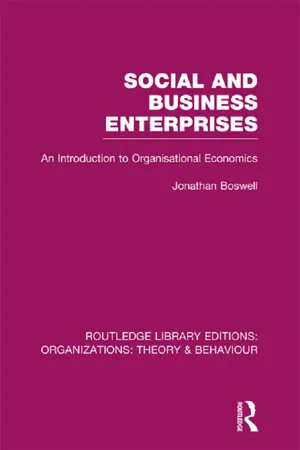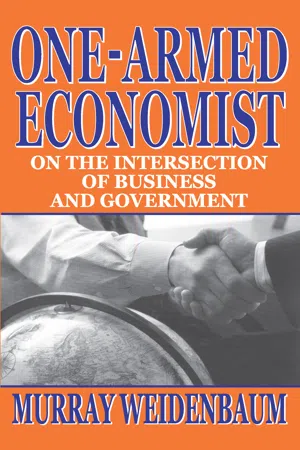Business
Managerial Economics
Managerial economics involves the application of economic theories and methodologies to make business decisions. It focuses on analyzing and solving business problems using economic principles. Managers use managerial economics to optimize resource allocation, understand consumer behavior, and make strategic decisions to maximize the firm's profits.
Written by Perlego with AI-assistance
Related key terms
4 Key excerpts on "Managerial Economics"
- eBook - ePub
Social and Business Enterprises (RLE: Organizations)
An Introduction to Organisational Economics
- Jonathan Boswell(Author)
- 2013(Publication Date)
- Routledge(Publisher)
Two further points need to be made about goals. First, there is the patent fact that organisations have multiple goals. Economists tend to cope with this problem in several ways. For example, in quantitative models one of an organisation's goals is regarded as dominant, with the others introduced as constraints. But in a more fundamental sense economic analysis is often precisely about the degree of consistency or ‘trade-off’ which may exist between different and often widely contrasted organisational goals. Second, the economic theory of decision making is not restricted to the dizzy heights of strategy and of dominant or overriding goals. It is also concerned with the microscopic logic of small decisions. The problem may be something as down-to-earth as appointing a foreman, scheduling meals on wheels for old people or deciding on suppliers of envelopes. Provided the decision means that scarce resources will move one way rather than another, however infinitesimally, the theory applies. But with many decisions the initial difficulty is one of correctly defining the problem. It is only when the problem has been clearly defined that an appropriate goal can be identified. That is why, in so many books on management loosely adhering to the economic approach, the first stage in decision making is specified as ‘problem formulation’. This emphasis is perfectly correct.EVALUATION OF COSTS AND BENEFITS
The third axiom of the economic theory of decision making, that the decision maker seeks to evaluate all relevant costs and benefits, poses great difficulties, both intellectual and practical. For what is the meaning of these slippery words ‘cost’ and ‘benefit’? What costs and benefits are ‘relevant’? Just those that can be quantified, or others as well? Just the costs and benefits affecting the organisation, or those affecting other people too? How do we actually perform the ‘careful evaluations’, particularly where the items we are concerned with appear to be measurable in principle but hardly in practice, measurable but not commensurable, or not even measurable at all? - eBook - ePub
- Neil Harris(Author)
- 2007(Publication Date)
- Routledge(Publisher)
Economics has had a major impact on the development of other intellectual disciplines such as business strategy, organisational behaviour, human resource management and marketing. All of these have drawn on it for parts of their theoretical content and, in turn, business economics draws on developments in these other areas. For example, Michael Porter’s work on competitive advantage, which is regarded as business strategy, has been highly influential and is explored in Chapter 7, Sections 7.1 and 7.2 as part of the broad framework of business economics as defined in this book. Marketing theories, which include the pricing strategies which businesses use for their products, are explored in Chapter 4. This drawing on other disciplines again gives a wider perspective to the analysis with which business economics is concerned and, in particular, the constraints within which businesses work. Using a spider diagram, Figure 1.2 illustrates these connections. Business economics therefore focuses on the issues directly relevant to a business and its operations, and to the business environment. This means, for example, that economic policy issues are not explored except in so far as they impact on a business’s operations, i.e. running the business in the short term, and its strategy, i.e. its long term plans and how to achieve them. What business economics and more general economics do share is the use of theories to try and explain how the economy works and impacts on businesses and households, and also how businesses work. A theory is defined by the Concise Oxford Dictionary as ‘a system of ideas explaining something, especially one based on general principles independent of the facts, phenomena etc to be explained’. So the theory of evolution, for example, seeks to explain how man developed from lower life forms over millions of years - eBook - ePub
- Cynthia Metcalf, Rhonda Atkinson, Rhonda Atkinson(Authors)
- 2017(Publication Date)
- Research & Education Association(Publisher)
Most contemporary definitions of economics involve the notions of choice and scarcity and their relationship to one another. Perhaps the earliest of these is by Lionel Robbins in 1935: “Economics is a science which studies human behavior as a relationship between ends and scarce means which have alternative uses.” Virtually all textbooks have definitions that are derived from this definition, though the exact wording differs from author to author.The standard definition of economics is something like this: “Economics is the social science that examines how people choose to use limited or scarce resources to obtain maximum satisfaction of unlimited wants.”Macroeconomics is the study of the economy as a whole and includes topics such as inflation, unemployment, and economic growth. Microeconomics is the study of the individual parts (e.g., households, business firms, and government agencies) that make up the economy. It particularly emphasizes both how these units make decisions and the consequences of these decisions.COMPETENCY 2.1Analyze how scarcity and opportunity cost influence choices about how to allocate resources.Economists believe that human wants are unlimited while the resources to satisfy those needs are limited. Consequently, society is never able to produce enough goods and services to satisfy everybody, or almost anyone, completely. Alternatively, resources are scarce relative to human needs and desires. When resources are limited, the limitation affects prices (the amount of money needed to buy goods, services, or resources). Scarcity - eBook - ePub
One-armed Economist
On the Intersection of Business and Government
- Murray Weidenbaum(Author)
- 2017(Publication Date)
- Routledge(Publisher)
Part 3 Applying Economics to Business 15 The Role of Economics in Business Planning This article draws on the author’s experience as the corporate economist for the Boeing Company as well as an extensive study of business planning he subsequently performed at the Stanford Research Institute. The state-of-the-art has advanced since the time of writing (1960s). An economist may make a number of contributions to business planning, particularly in relating the external economic environment to company decision making. This article briefly describes the business planning process and then discusses how economics and economists can contribute to that process. It is a synthesis of available information on industrial economics and is not limited to the experience of a single company. The literature on business planning is sufficiently voluminous without adding to the available descriptions of techniques to be used in preparing planning documents or in organizing the planning operation. However, the repetition of a few fundamentals of planning may be beneficial both to those who participate in the process and those outside of it who wish to understand it. Fundamentally, business planning is not, or at least should not be, merely a collection of estimates of future sales, profits, manpower, or other statistical forecasts. To cite the obvious, Webster’s New International Dictionary informs us that to plan is “to devise or project as a method or course of action.” Here we have the essence of business planning: it is a process that is designed to provide a course of action for a business enterprise. The statistical data merely furnish a basis for decisions. The present article is primarily concerned with the overall planning of a diversified business enterprise rather than the planning performed by an individual division or department
Index pages curate the most relevant extracts from our library of academic textbooks. They’ve been created using an in-house natural language model (NLM), each adding context and meaning to key research topics.



